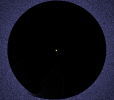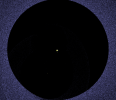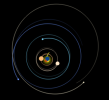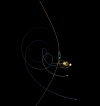You are using an out of date browser. It may not display this or other websites correctly.
You should upgrade or use an alternative browser.
You should upgrade or use an alternative browser.
Computational modelling of the companion star and its interaction with Sol
- Thread starter tohuwabohu
- Start date
tohuwabohu
Jedi Master
That's a nice one.MoonGlow said:(As a silly aside, I am switching my forum browser to the black motif with the comet in honor of this thread.)

tohuwabohu
Jedi Master
That would be great, because the companion gives pretty large gravity potential trace, so it can be easy to locate her if some data are available.MoonGlow said:It may be of some interest to you to know that the spaceship New Horizon is in flight, and will reach the Kuiper belt in 2015. We'll know a lot more about the subtle nuances of the gravitational fields affecting the Kuiper objects, and we'll have a wealth of new data to play with.
On the other hand I doubt they will make publicly available anything that might help to locate the companion because the research about the companion is practically on par with the research about secret history.
MrEightFive
Jedi
Actually, for 2015 only Pluto-Charon system encounter is scheduled, Kuiper belt objects exploration is expected in 2018-2022, so good luck with waiting...MoonGlow said:It may be of some interest to you to know that the spaceship New Horizon is in flight, and will reach the Kuiper belt in 2015. We'll know a lot more about the subtle nuances of the gravitational fields affecting the Kuiper objects, and we'll have a wealth of new data to play with.
tohuwabohu
Jedi Master
Here are some results of the simulations I've been doing last couple of days. I tried to see the mechanism of how the wake is created and what does it look like in some dense regions. For this I created only a small patch of the cloud with high density of asteroids and then let the companion go through with fairly small time stepping. I varied the time integration step size to see the effect and that is how I found about the inaccuracy. So the resulting time step was only few days.
Basically I made three simulations, one was with patch 10,000 AU away (the outer border of the cloud), one was in the middle at approx 5000 AU and one was at the inner border (1000 AU). The results of the two simulations far away were practically identical and can be seen in the figure 1e4au and in the video that can be downloaded here
_http://www.fileswap.com/dl/fIjI5d2Qo5/
The results of inner border were different and can be seen either in the pictures or in the video here
_http://www.fileswap.com/dl/CE1hcRzm75/
Basically what I observe is that when the companion hits the cloud it ejects the asteroids in an almost circular (spherical in 3D) pattern with exception in front of her where a cone like shape is created. I tried to obtain an enclosed circular pattern without the wedge but couldn't get such results with realistic velocity of the companion and the asteroids. I assume stable orbit for the asteroids so their velocity is according to Kepler's law and the companion velocity is calculated from the very first simulation where I observed the period and perihelion distance. Also I assume that all the asteroids orbit the Sun in the same direction but the direction only gives an asymetrical shape of the cone. If the asteroids were standing still then the cone would be exactly in front of the companion, here it is under some angle.
Another thing I tried is to change mass ditribution of the asteroids but that of course didn't have any impact on the shape of the wake. The wedge only gets wider with increased velocity of the companion.
Thus at the inner boundary of the oort cloud the asteroids are not ejected directly towards Sun but more like around him.
When the companion is far away from Sun, she can literally pull back some of the ejected asteroids and attaches them to her so they are orbiting her in a fairly stable orbits even though each might have different orbit eccentricity and direction of orbit. One can see a heart shape like formation as she pulls to her the asteroids from the left and right side of the wake. And this goes perpetually through almost all the cloud so it might resemble a snow ball rolling down the hill getting bigger and bigger.
At the inner boundary the ejected asteroids are slowly attracted to the sun. I should have increased the dot size because the density is so dispersed that there is almost nothing to see in the pictures. Compared to the cloud density the density of the ejecta is 5 times lower. Well I counted the particles per 10 pixels square so it is not exact. In 3D it would be even more pronounced. So if one closely looks, only the edge of the cone is attracted to the sun and some of the particles are sucked in while the companion is on her approach.
What I learned is that neglecting the electric properties the size of the asteroids (and the mass) doesn't play almost no role in the dispersion pattern, or whether the asteroid gets attached or not. Also no matter what I did the asteroids are not thrown directly to the sun but more in a roundabout way. The wake created from the outer region of the oort cloud actually was directed toward the sun, but assuming the distance it will be dispersed while it comes near so it doesn't play important role.
So what is left is that the asteroids that are attached to the companion are perhaps the most important factor of the interaction with solar system.
The problems that I found are that in order to simulate accurately the close interaction of all the bodies the integration step would have to be very small to properly resolve the trajectory and I am able to pack densely only small patches of the cloud.
You know say I would like to simulate the approach all the way from 10,000 AU to the sun. Say it takes 74,000 years for the companion the travel that distance. If I use step size of one day, that means that the computer has to calculate 74,000 * 365 = 27,010,000 steps and if one step takes 5 seconds to calculate then we have 135,050,000 seconds,so it takes roughly 4 years for the job to be completed.
And the temporal accuracy is very important so I will try to improve the integration method. And it is clear that I can only put the companion somewhere near the inner border because else I would have to wait for years.
But what I am thinking now is that I can actually make a pretty good guess of how much bodies she can attach to herself and simply put her closer with all her minions orbiting her and see what happens.
This is a good idea. Ok so my first task is the integration method and then I recheck the results and will continue.
Basically I made three simulations, one was with patch 10,000 AU away (the outer border of the cloud), one was in the middle at approx 5000 AU and one was at the inner border (1000 AU). The results of the two simulations far away were practically identical and can be seen in the figure 1e4au and in the video that can be downloaded here
_http://www.fileswap.com/dl/fIjI5d2Qo5/
The results of inner border were different and can be seen either in the pictures or in the video here
_http://www.fileswap.com/dl/CE1hcRzm75/
Basically what I observe is that when the companion hits the cloud it ejects the asteroids in an almost circular (spherical in 3D) pattern with exception in front of her where a cone like shape is created. I tried to obtain an enclosed circular pattern without the wedge but couldn't get such results with realistic velocity of the companion and the asteroids. I assume stable orbit for the asteroids so their velocity is according to Kepler's law and the companion velocity is calculated from the very first simulation where I observed the period and perihelion distance. Also I assume that all the asteroids orbit the Sun in the same direction but the direction only gives an asymetrical shape of the cone. If the asteroids were standing still then the cone would be exactly in front of the companion, here it is under some angle.
Another thing I tried is to change mass ditribution of the asteroids but that of course didn't have any impact on the shape of the wake. The wedge only gets wider with increased velocity of the companion.
Thus at the inner boundary of the oort cloud the asteroids are not ejected directly towards Sun but more like around him.
When the companion is far away from Sun, she can literally pull back some of the ejected asteroids and attaches them to her so they are orbiting her in a fairly stable orbits even though each might have different orbit eccentricity and direction of orbit. One can see a heart shape like formation as she pulls to her the asteroids from the left and right side of the wake. And this goes perpetually through almost all the cloud so it might resemble a snow ball rolling down the hill getting bigger and bigger.
At the inner boundary the ejected asteroids are slowly attracted to the sun. I should have increased the dot size because the density is so dispersed that there is almost nothing to see in the pictures. Compared to the cloud density the density of the ejecta is 5 times lower. Well I counted the particles per 10 pixels square so it is not exact. In 3D it would be even more pronounced. So if one closely looks, only the edge of the cone is attracted to the sun and some of the particles are sucked in while the companion is on her approach.
What I learned is that neglecting the electric properties the size of the asteroids (and the mass) doesn't play almost no role in the dispersion pattern, or whether the asteroid gets attached or not. Also no matter what I did the asteroids are not thrown directly to the sun but more in a roundabout way. The wake created from the outer region of the oort cloud actually was directed toward the sun, but assuming the distance it will be dispersed while it comes near so it doesn't play important role.
So what is left is that the asteroids that are attached to the companion are perhaps the most important factor of the interaction with solar system.
The problems that I found are that in order to simulate accurately the close interaction of all the bodies the integration step would have to be very small to properly resolve the trajectory and I am able to pack densely only small patches of the cloud.
You know say I would like to simulate the approach all the way from 10,000 AU to the sun. Say it takes 74,000 years for the companion the travel that distance. If I use step size of one day, that means that the computer has to calculate 74,000 * 365 = 27,010,000 steps and if one step takes 5 seconds to calculate then we have 135,050,000 seconds,so it takes roughly 4 years for the job to be completed.
And the temporal accuracy is very important so I will try to improve the integration method. And it is clear that I can only put the companion somewhere near the inner border because else I would have to wait for years.
But what I am thinking now is that I can actually make a pretty good guess of how much bodies she can attach to herself and simply put her closer with all her minions orbiting her and see what happens.
This is a good idea. Ok so my first task is the integration method and then I recheck the results and will continue.
Attachments
tohuwabohu
Jedi Master
I ain't waiting that long, it might be already everything over then.MrEightFive said:Actually, for 2015 only Pluto-Charon system encounter is scheduled, Kuiper belt objects exploration is expected in 2018-2022, so good luck with waiting...MoonGlow said:It may be of some interest to you to know that the spaceship New Horizon is in flight, and will reach the Kuiper belt in 2015. We'll know a lot more about the subtle nuances of the gravitational fields affecting the Kuiper objects, and we'll have a wealth of new data to play with.
tohuwabohu
Jedi Master
Where did Pierre get to this number?
Session 21 june 2014
I mean if that would be the case then the solar system would turn from that
Session 21 june 2014
A: Yes but not massive in stellar terms.
Q: (L) Well, okay, so just massive relative to the earth.
(Perceval) Well, is it massive relative to the earth?
(L) I think it is.
(Pierre) We asked that question about the size of Nemesis, and it was 0.56 the mass of the sun.
(Andromeda) Half the sun.
(Pierre) Yeah, relative to human beings, it's quite large.
(L) Relative to the size of the earth, that's quite a bit.
I mean if that would be the case then the solar system would turn from that
Attachments
tohuwabohu
Jedi Master
tohuwabohu
Jedi Master
In other words the outer planets would be completely torn out of their orbits.
I do not know if this is plausible, because I remember that it was said that the companion would instead reset the solar system into its original configuration. The planetary axes will be aligned and so on but it can be caused by the electric current.
I do not know if this is plausible, because I remember that it was said that the companion would instead reset the solar system into its original configuration. The planetary axes will be aligned and so on but it can be caused by the electric current.
Palinurus
The Living Force
Where did Pierre get to this number?
Hi tohuwabohu,
The 0.56 figure was discussed previously on page one of this topic, notably in Reply #7 through #12.
The original source appeared to be referenced without specifics in Session January 30, 2010 which also mentions the possibility of perturbations:
(Ark) Gravitational anomalies.
(L) Well, what do you mean?
(Ark) I mean Pioneer trajectory has anomaly, all kinds of rotating galaxies have anomalies...
(L) But you just said it was all predictable.
(Ark) Oh, it's predictable on a more or less... I mean, they are small anomalies, not big anomalies. I want to ask about my numbers. So, I put numbers. We were asking for these numbers years ago, you were evasive, and you even admitted that you are evasive for a good reason. Nevertheless, I did calculations with what I could - of course garbage in/garbage out as everyone knows. So, I put for the period 26 million years. Is it approximately true?
A: Very close 28.2 million years.
Q: (Ark) Then I had to put another number which was not told to us. I was asking about the mass of this companion star, and I was told that it was "much less than the sun". So, in my calculations, I put half a percent of the mass of the sun. Is it approximately true?
A: 3.4, closer
Q: (Ark) 3 percent?! And not half a percent?? That would mean that when it approaches, it will induce perturbation of the solar system.
A: Indeed!
Q: (Ark) Hmm.
A: It already has done so in the past. Just check the record.
Q: (Joe) It's already perturbed in the past?
(L) So in other words, you can examine the record and find out what kind of perturbations it does. Like the geological record, historical record, archaeology, etc.
(Ark) I will do this. Now, just one other question to check. I calculated from these data - the difference in the mass between what I thought. And what we just learned will not influence these calculations - it has to do with perturbations - so, I calculated what we call a semi-major axis. So there is the binary system, there is the sun and there is this companion. And they circulate around each other. But the sun moves only a little bit because it's heavy. So I calculated the semi-major axis. It's a flat elliptical orbit. So we know the semi-minor axis because we were told it's around Pluto distance. So I calculated the semi-major axis and I got the answer like 87,000 astronomical units, which is about 1.3 light years, a the semi-major axis of this elongated ellipse. Is this 1.3 light years more or less the right answer?
A: 1.7
Q: (Ark) Okay. Thank you very much. That's enough for me to go back to my calculations and use cleverly what I just got.
tohuwabohu
Jedi Master
Ah I see, thank you Palinurus.
Pierre just confused me totally because he mentioned the 56 percent in recent transcript and I was thinking that the new sessions are much more accurate compared to those from 1998.
But it is also true that the C's did not react to that. Until now I thought that the theoretical limit of the brown dwarf is 7 percent mass of the sun. But there is something on the idea that the ignition has something to do with electric stress. In that case the theoretical limit on the mass is nonexistent, or unknown if an assumption is made that the electric, magnetic and gravitational fields are interwowen. So now I am puzzled as to where the truth is.
Pierre just confused me totally because he mentioned the 56 percent in recent transcript and I was thinking that the new sessions are much more accurate compared to those from 1998.
But it is also true that the C's did not react to that. Until now I thought that the theoretical limit of the brown dwarf is 7 percent mass of the sun. But there is something on the idea that the ignition has something to do with electric stress. In that case the theoretical limit on the mass is nonexistent, or unknown if an assumption is made that the electric, magnetic and gravitational fields are interwowen. So now I am puzzled as to where the truth is.
Palinurus
The Living Force
So now I am puzzled as to where the truth is.
It has been a persistent confusion all along, I would say. Maybe Pierre's book has more clues you could use?
tohuwabohu
Jedi Master
Palinurus said:So now I am puzzled as to where the truth is.
It has been a persistent confusion all along, I would say. Maybe Pierre's book has more clues you could use?
I had a look and he uses 56 % also in his book and explains that the mass has nothing to do with the brown dwarf classification. It is the electric stress that is too small for the dark star to be ignited. Thus it can be ignited only after it is in the heliosphere.
I personally think that the 56 % is too much.
Palinurus
The Living Force
I personally think that the 56 % is too much.
I think you're right about that.
Evidently, somehow Pierre got stuck on a faulty and obsolete assumption in this matter, and apparently didn't notice the number of about 3.4% given in the January 30, 2010 session -- which amounts to the latest answer the C's have given on this subject that I'm aware of. It's a pity his book also carries this faulty number, while it easily could've been corrected before printing.
axj
The Living Force
I also think that a large companion can be ruled out since the WISE mission did not find it in 2013. It could detect objects as cool as 150 Kelvin.
3% of the solar mass means that the companion would be about 30 times as massive as Jupiter.
According to Wikipedia:
"The theoretical minimum mass a star can have, and still undergo hydrogen-1 fusion at the core, is estimated to be about 75 times the mass of Jupiter, while fusion of deuterium can occur at masses as low as 13 Jupiters."
_http://en.wikipedia.org/wiki/Jupiter_mass
3% of the solar mass means that the companion would be about 30 times as massive as Jupiter.
According to Wikipedia:
"The theoretical minimum mass a star can have, and still undergo hydrogen-1 fusion at the core, is estimated to be about 75 times the mass of Jupiter, while fusion of deuterium can occur at masses as low as 13 Jupiters."
_http://en.wikipedia.org/wiki/Jupiter_mass





